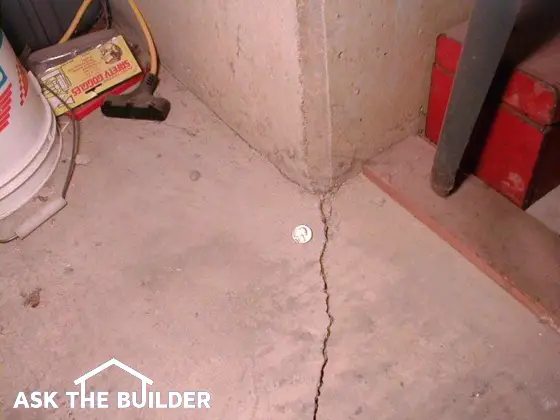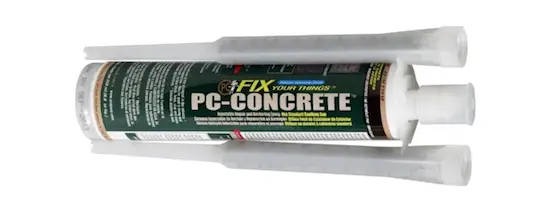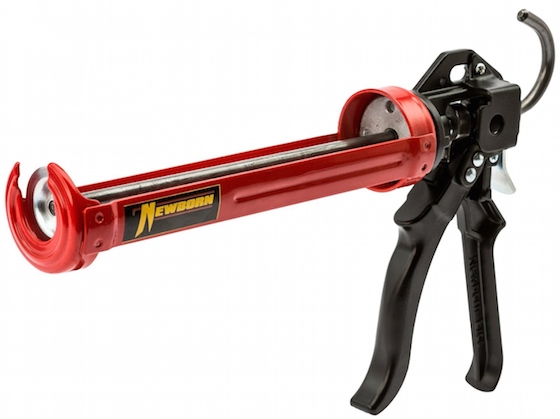Concrete Crack Repair Tips

Concrete Crack Repair | Here's a normal concrete shrinkage crack in a basement slab. One year after the slab is poured you can start to think about repairing it. You have several options. See below. Copyright 2019 Tim Carter
Concrete Crack Repair Tips - It's Detail Work
What Concrete Crack Repair Options Are Available?
You have several options to repair concrete cracks:
- inject the crack with epoxy
- fill it with gray ceramic tile grout
- patch with expanding hydraulic cement
What is the Best Epoxy To Use?
The best epoxy for concrete crack repair, in my opinion, is made by PC Products.

This is the magic epoxy that fits into a regular caulk gun. I've used it with great success. CLICK on THE PHOTO NOW TO HAVE IT DELIVERED TO YOUR HOME.
As you might imagine, the prep work before installing your patching material is the most important part of the job. This is really true of most building and remodeling jobs.
Why is Prep Important?
The concrete surfaces need to be clean and free of all dust and anything else that will interfere with the bonding of the repair material to the sides of the crack.
Is Epoxy the Best Material for Concrete Crack Repair?
Epoxy is a fantastic repair material. Most are quite thick so the crack needs to be about 1/4-inch wide for you to be able to inject the epoxy with ease.
You can buy a durable epoxy that has a special mixing nozzle. I demonstrate it in this video:
What is the Caulk Gun in the Video?
Here's the fantastic caulk gun I used in the video. It's designed to give you lots of control when you squeeze the handle.

My caulk gun is just like this one. Once you use a gun like this, you'll throw away the one you have that has the click notches. They're pieces of crap. CLICK on THE IMAGE NOW TO ORDER THIS GUN.
How Do You Repair Cracks and Holes on Flat Concrete?
You can use sanded ceramic tile grout or Portland cement mixed with fine or medium sand to repair large cracks and holes in concrete.
Most repairs on flat surfaces, such as a driveway, patio or sidewalk, consist of filling a depression or hole. The hole usually has tapered sides.
These tapered edges can cause real problems for the long term durability of the patch. The patching compounds thin out at these spots and can easily peel or fail. The result is an unsightly second area to patch the following month or year.
How Do You Prevent the Failure of the Patching Compound?
I have had the best success patching when I alter the sides of these holes. This can be done with either a chisel and a hammer or a saw equipped with a masonry blade.
NOTE: Always wear eye protection and/or ear protection when doing this type of work. Small pieces of concrete, dust, metal or masonry blades can cause severe eye injury. Hearing loss is a real threat as well.
The challenge is to remove the taper from the edges of the hole. If you are successful, the finished edges will be 1/8 inch thick or so instead of tapering to a feather edge.
SECRET TIP: Mix pure Portland cement with water to the consistency of latex paint. Brush this into the crack or the hole immediately before filling with the patching material. Do NOT allow the cement paint to dry. Work FAST.
How Do You Mix the Patching Materials?
Always follow directions. Most compounds should achieve the consistency of cake icing or a very thick gravy (don't eat these compounds!) Only mix enough compound that you can apply in 15 to 20 minutes.
How Do You Apply the Patching Material?
When using water-based repair compounds, wet the surface to be patched, if you are not using a bonding agent. If using a bonding agent follow directions carefully.
For deep repairs, consider installing hardened nails in the depression. For extra deep repairs, drill a 1/2 inch diameter hole and pound a 1/2 inch piece of reinforcing steel into the hole. These items will help hold the patch in place. Be sure that these pieces of steel are at least 1/2 inch below the top of the patch.
Use a finishing tool (magnesium or wood float, steel trowel, etc.) to finish your patched area. Finishing is an art and takes practice. You may have to wait a few minutes until the patching compound begins to stiffen to achieve the desired results. Practice in some out of the way spot, if in doubt.
When you are satisfied with the patch, cover it with a piece of plastic. Weight the edges of the plastic so it will not blow away and so air cannot blow underneath the plastic. This is very important!! Keep the plastic in place for three to four days.
What are the Best Weather Conditions to do Concrete Crack Repair?
Sunny, hot, breezy weather is the worst time to do this type of work! Many people think it is the best time. These conditions cause the patching compound to dry out too fast. Fifty-five degree F weather, overcast and damp is a great time to do this work. If you insist on doing it in warm weather, do it in the early morning. Then, shade the repairs so the sun can't hit them.
Don't attempt to repair concrete in freezing weather. The patches will readily freeze and fail. Use common sense.
5 Responses to Concrete Crack Repair Tips